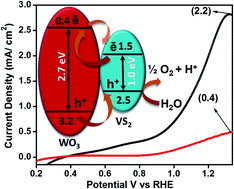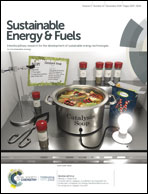Design of noble metal free hierarchical VS2 onto WO3 nanoflakes as an effective heterojunction strategy for enhanced photoelectrochemical water oxidation†
Abstract
WO3 is a promising photoanodic material for photoelectrochemical oxygen evolution. However, its use is limited due to its slower surface reaction kinetics leading to undesired carrier recombination. Herein, we propose the design of highly surface reactive and noble metal free VS2 nanoflowers onto an in situ grown WO3 photoanode as a heterojunction strategy for efficient charge separation. VS2, a promising transition metal-based material with active sites both on the edge and basal planes, reduces the surface charge recombination and enhances the kinetics of the O2 evolution reaction at the photoanode and electrolyte interface. A significant increment in photocurrent density is observed for the WO3–VS2 composite compared to the bare WO3 with an increase in charge carrier density from 2.5 × 1021 for WO3 to 1.5 × 1022 cm3 for WO3–VS2. Electrochemical impedance spectroscopy indicates an effective reduction in charge transfer resistance from 7.71 × 105 for WO3 to 2.79 × 103 Ω for WO3–VS2. A faradaic efficiency of 87% is indicative that the oxygen generated in the reaction is mainly due to the photoelectrochemical water oxidation.



 Please wait while we load your content...
Please wait while we load your content...